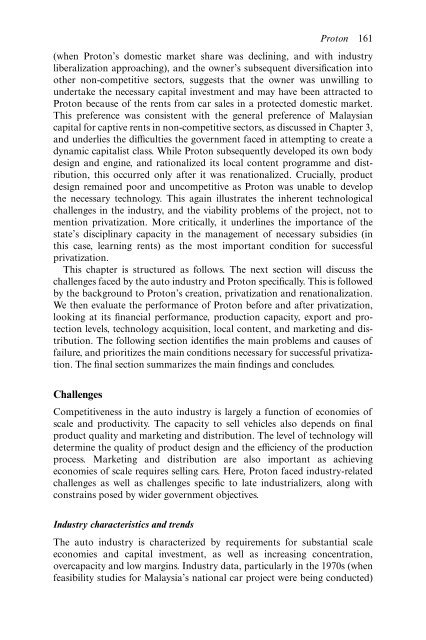PRIVATIZATION Privatization in Malaysia, Regulation, rent-seeking and policy failure
PRIVATIZATION Privatization in Malaysia, Regulation, rent-seeking and policy failure
PRIVATIZATION Privatization in Malaysia, Regulation, rent-seeking and policy failure
Create successful ePaper yourself
Turn your PDF publications into a flip-book with our unique Google optimized e-Paper software.
Proton 161(when Proton’s domestic market share was decl<strong>in</strong><strong>in</strong>g, <strong>and</strong> with <strong>in</strong>dustryliberalization approach<strong>in</strong>g), <strong>and</strong> the owner’s subsequent diversification <strong>in</strong>toother non-competitive sectors, suggests that the owner was unwill<strong>in</strong>g toundertake the necessary capital <strong>in</strong>vestment <strong>and</strong> may have been attracted toProton because of the <strong>rent</strong>s from car sales <strong>in</strong> a protected domestic market.This preference was consistent with the general preference of <strong>Malaysia</strong>ncapital for captive <strong>rent</strong>s <strong>in</strong> non-competitive sectors, as discussed <strong>in</strong> Chapter 3,<strong>and</strong> underlies the difficulties the government faced <strong>in</strong> attempt<strong>in</strong>g to create adynamic capitalist class. While Proton subsequently developed its own bodydesign <strong>and</strong> eng<strong>in</strong>e, <strong>and</strong> rationalized its local content programme <strong>and</strong> distribution,this occurred only after it was renationalized. Crucially, productdesign rema<strong>in</strong>ed poor <strong>and</strong> uncompetitive as Proton was unable to developthe necessary technology. This aga<strong>in</strong> illustrates the <strong>in</strong>he<strong>rent</strong> technologicalchallenges <strong>in</strong> the <strong>in</strong>dustry, <strong>and</strong> the viability problems of the project, not tomention privatization. More critically, it underl<strong>in</strong>es the importance of thestate’s discipl<strong>in</strong>ary capacity <strong>in</strong> the management of necessary subsidies (<strong>in</strong>this case, learn<strong>in</strong>g <strong>rent</strong>s) as the most important condition for successfulprivatization.This chapter is structured as follows. The next section will discuss thechallenges faced by the auto <strong>in</strong>dustry <strong>and</strong> Proton specifically. This is followedby the background to Proton’s creation, privatization <strong>and</strong> renationalization.We then evaluate the performance of Proton before <strong>and</strong> after privatization,look<strong>in</strong>g at its f<strong>in</strong>ancial performance, production capacity, export <strong>and</strong> protectionlevels, technology acquisition, local content, <strong>and</strong> market<strong>in</strong>g <strong>and</strong> distribution.The follow<strong>in</strong>g section identifies the ma<strong>in</strong> problems <strong>and</strong> causes of<strong>failure</strong>, <strong>and</strong> prioritizes the ma<strong>in</strong> conditions necessary for successful privatization.The f<strong>in</strong>al section summarizes the ma<strong>in</strong> f<strong>in</strong>d<strong>in</strong>gs <strong>and</strong> concludes.ChallengesCompetitiveness <strong>in</strong> the auto <strong>in</strong>dustry is largely a function of economies ofscale <strong>and</strong> productivity. The capacity to sell vehicles also depends on f<strong>in</strong>alproduct quality <strong>and</strong> market<strong>in</strong>g <strong>and</strong> distribution. The level of technology willdeterm<strong>in</strong>e the quality of product design <strong>and</strong> the efficiency of the productionprocess. Market<strong>in</strong>g <strong>and</strong> distribution are also important as achiev<strong>in</strong>geconomies of scale requires sell<strong>in</strong>g cars. Here, Proton faced <strong>in</strong>dustry-relatedchallenges as well as challenges specific to late <strong>in</strong>dustrializers, along withconstra<strong>in</strong>s posed by wider government objectives.Industry characteristics <strong>and</strong> trendsThe auto <strong>in</strong>dustry is characterized by requirements for substantial scaleeconomies <strong>and</strong> capital <strong>in</strong>vestment, as well as <strong>in</strong>creas<strong>in</strong>g concentration,overcapacity <strong>and</strong> low marg<strong>in</strong>s. Industry data, particularly <strong>in</strong> the 1970s (whenfeasibility studies for <strong>Malaysia</strong>’s national car project were be<strong>in</strong>g conducted)


